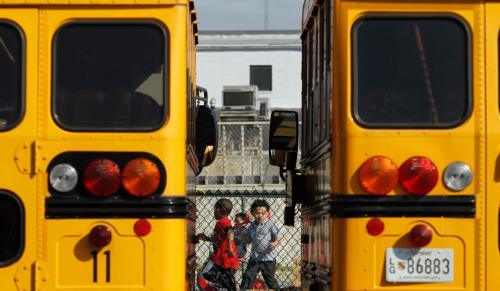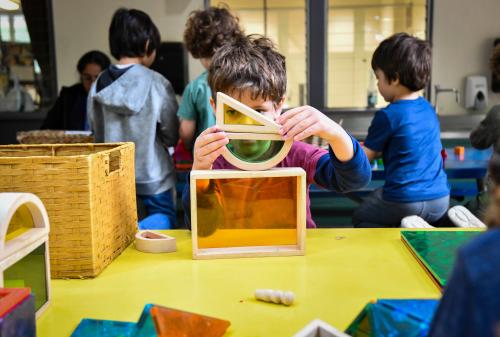This fall, only half of American K-12 districts started the school year fully in-person. Policymakers, the media, and families engaged in prolonged public debates about whether schools can reopen safely and how best to balance concerns about children’s learning with the need to reduce the spread of COVID-19. There was extensive public discourse about the need to protect teachers—specifically, K-12 teachers. With few exceptions, teachers who work in child-care centers were excluded.
This isn’t new. As a society, we have long treated teachers working with young children differently than other teachers. There is, however, no rational justification for this difference. Whether working in a child-care center or school, with toddlers or fourth graders, the people who teach young children every day do complex work, scaffolding children’s academic, social, and emotional development during a foundational period in their lives. They also provide essential child care to ensure working parents can do their jobs—a reality highlighted by COVID-19.
Yet the way we treat and compensate teachers is entirely different based on the ages of the children they serve. And even among early childhood education (ECE) teachers working with very young children (ages 0-5), those in schools experience substantially better working conditions than teachers working in child-care centers.
Results from a pre-COVID-19 survey of ECE teachers
We have been documenting these patterns as part of a research policy partnership with Virginia‘s Department of Education. In 2019, we surveyed over 1,000 ECE lead teachers participating in Virginia’s Preschool Development Grant Birth-Five initiative. This included over 600 teachers working in child-care centers and about 400 working in school-based ECE.
Table 1 presents results from our spring 2019 baseline survey, and it shows large differences between early childhood educators working in child care and those working in schools. For example, about half of teachers in child-care centers held a high school degree or less. In contrast, nearly all school-based lead teachers held a bachelor’s degree or more. While almost 40% of child-care teachers had annual household incomes under $25,000, just 1% of school-based ECE teachers fell into this category. Notably, the racial composition of these two groups of teachers also varied. Nearly half of child-care center teachers were people of color: 25% were Black, 12% Hispanic, and 10% identified as another race/ethnicity. In contrast, only 14% of school-based teachers were people of color.
Table 1: Lead Teachers’ Characteristics Across Early Childhood Settings (May 2019)
| Characteristic | Centers | Schools | ||
| Mean | Mean | |||
| High school degree or less | 51% | 1% | ||
| Bachelor’s or higher degree | 33% | 98% | ||
| Household income < $25,000/year | 38% | 1% | ||
| Household income < $45,000/year | 67% | 11% | ||
| Household income > $100,000/year | 5% | 30% | ||
| White, non-Hispanic | 54% | 86% | ||
| Black, non-Hispanic | 25% | 7% | ||
| Hispanic | 12% | 4% | ||
| Other race/ethnicity | 10% | 3% | ||
| Note: Based on responses from ~510 teachers in child-care centers and ~355 teachers in school-based ECE programs who took both the 2019 baseline survey and the 2020 follow-up survey. | ||||
Results from a follow-up survey during the pandemic
Long-standing disparities in teacher earnings and well-being were exacerbated by COVID-19. By mid-March, most states shut down public schools, and teachers, including ECE teachers, transitioned to remote instruction while maintaining their pay. In contrast, child-care teachers faced both health and economic stressors. They served as frontline pandemic workers—teaching and caring for the children of essential workers—even as many families stopped paying for care and centers struggled to stay open.
To learn more about the experiences of early childhood educators during the pandemic, we re-surveyed our same group of ECE teachers in May 2020 (along with a small number of teachers who took the follow-up survey but not the baseline survey).
All school-based early childhood teachers surveyed reported that they were still employed in May 2020, and just 3% of school-based teachers reported not working. In contrast, Figure 1 shows that one-third of child-care teachers (34%) were either no longer employed or no longer working. Many still-employed child-care teachers (27%) also reported decreased hours. Overall, child-care teachers were over five times more likely to report decreased weekly earnings relative to school-based teachers (38% compared to 7%). Notably, this figure may still understate the challenges faced by child-care teachers, as it includes a small number of teachers in federally funded Head Start programs that were able to close but maintain teacher pay.
Early childhood educators across all settings reported high levels of financial insecurity this past spring, but child-care teachers faced these challenges at far higher rates. They were at least twice as likely to report each of the financial difficulties highlighted in Figure 2. For example, 4% of school-based teachers indicated that many of their bills were past due; three times as many child-care teachers reported this concern (12%). Half as many school-based teachers (15%) as child-care teachers (33%) reported that they worried that they would run out of money before they were paid again.
Teachers’ ability to meet their basic needs followed this same pattern. Five percent of school-based teachers indicated that they had run out of food and did not have the money to buy more at least sometimes in the past three months; this was true for 29% of child-care teachers. Six percent of school-based teachers indicated that they could not afford housing costs (e.g., mortgage, rent, utilities) in the past three months, compared with three times as many child-care teachers (18%).
Finally, 11% of school-based teachers indicated that they did not have enough money to meet their medical needs, in contrast to over one-third (35%) of child-care teachers. This may be related to child-care teachers’ more limited resources for health care. Thirteen percent of child-care teachers reported that they had no health insurance, as compared to 2% of school-based teachers. And, while the large majority of school-based teachers (80%) reported having health-care benefits through their jobs, this was true for only 40% of child-care teachers.
COVID-19 has highlighted the extent to which we undervalue and under-support child-care teachers as compared to their school-based counterparts. When schools made the difficult decision to move to remote learning, child-care centers stepped in to support children, their families, and the economy. But they were not given the funding they needed to keep their teachers financially secure.
In the wake of this pandemic, when the importance of child care has become so salient for so many Americans, we have an opportunity to reimagine early education and dismantle long-standing disparities both between centers and school-based ECE programs, and between ECE and K-12 teachers.
As policymakers at all levels debate COVID-19 relief measures, a major investment in the child-care workforce specifically—whether through access to health insurance, debt forgiveness, refundable tax credits, or other supports—is essential to ensure the immediate safety and well-being of these educators, and the children, families, and communities they serve. Long-term, sustained funding and an overhaul of how we compensate the ECE workforce are also critical. Whether they work in child-care centers or schools, with infants or with elementary schoolers, teachers provide essential services and must, at the very minimum, have their basic needs met.
Justin B. Doromal, Deiby Mayaris Cubides-Mateus, and Sarah Kiscaden contributed substantially to this post.









Commentary
COVID-19 highlights inequities in how we treat early educators in child care vs. schools
October 23, 2020